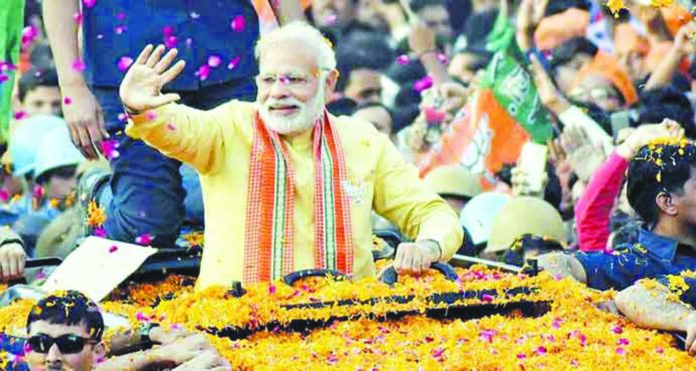Despite the COVID-19 pandemic’s mismanagement, economic turmoil, and vigorous farmer protests in India, Prime Minister Narendra Modi emerged victorious in state elections last year, with Yogi Adityanath, a far-right Hindu extremist, securing a sweeping victory in Uttar Pradesh. This time around, there is widespread certainty that the Bharatiya Janata Party (BJP) and the National Democratic Alliance (NDA) will secure power for the third consecutive term in the upcoming elections, as reflected in their slogan “ab ke baar, 400 paar,” indicating the expected number of seats the alliance aims to secure in the legislative assembly. This confidence shows how in the past 10 years the BJP has come to dominate the electoral landscape, making the Indian National Congress and other parties almost irrelevant.
The most defining reason for Prime Minister Narendra Modi’s electoral dominance is how he has employed jingoistic Hindu nationalism time after time to appease the Hindu majoritarian impulses. This catapulted him into power and solidified his party as the mainstay of Indian politics, knocking Congress off its perch. Whether it is the Balakot Strike to foment nationalistic fervour at the time of elections, or the recent opening of the Ram Mandir in place of the Babri Mosque destroyed by Hindu extremists, or the abrogation of Article 370, Modi’s insidious use of xenophobia, chauvinism, and Hindutva ideology has all but cemented his victory in the upcoming elections.
But to attribute the dominance of BJP’s electoral machine only to Hindutva would not be entirely correct. Much like far-right nationalist leaders like Mussolini and Hitler in the past, Modi is also hands in glove with the corporate elite of the country. This symbiotic relationship between the business elite and the Modi-led BJP has meant that the BJP enjoys the most funding from these wealthy individuals who fund the extraordinary electoral campaigning by the ruling party in elections. Furthermore, most of the media houses are run by pro-BJP tycoons and are acting as propaganda centres for the BJP. If this wasn’t enough, Modi’s government has used state machinery against the few media channels that still voice valid criticism against Modi’s politics of haste. This metamorphosis of media houses into propaganda centres and subjugation of Anti-Modi voices has made PM Modi the most popular leader in the country with virtually no opposition and at the cost of the downgrading of Indian democratic credentials by international organisations.l
One other element in the electoral dominance of the BJP is the unravelling of the Indian National Congress. The Congress leadership seems to be in disarray with no sense of direction as to how to deal with the ruling party’s electoral onslaught. Secondly, it seems like there is a growing sentiment against dynastic politics in the Indian electorate. Congress’s obstinacy in still persisting with the Gandhi-Nehru family has held the party back in recent times from effectively mounting a credible opposition against BJP.
The impending re-election of Modi suggests continuity in India’s approach towards South Asia, maintaining and perpetuating the existing dynamics in regional relations; unless a profound change in the geopolitical landscape takes place that demands recalibration of relations.
All of the above-mentioned whys and wherefores make the upcoming election in India just a formality where the only unfamiliar outcome will be how many seats the BJP wins to form the government. So, what will the third consecutive term for PM Modi, who has repeatedly used his jingoist Hindu narrative to gain support and that has only increased with time, mean for South Asia, particularly Pakistan?
A victory for Narendra Modi in the upcoming election is likely to mean continuity in its India-Pakistan relations, with the continuation of the status quo modus vivendi that has characterized their interactions in the past. This modus operandi has typically involved periods of intermittent dialogue interspersed with escalations in border tensions, particularly in Kashmir. Modi’s fierce Hindu nationalist underpinnings coupled with his rhetoric of a rising and a strong India suggests that his approach towards Pakistan is unlikely to undergo significant change.
But there exists an extremely remote chance that the victory of PM Modi in the upcoming elections could potentially usher in a thaw in the tense relationship between Pakistan and India. Past patterns suggest that when the BJP governs India and the PML(N) holds power in Pakistan, there tends to be receptivity to political overtures.
Similarly, Modi’s expected victory is likely to continue India’s current approach toward its smaller neighbours which is characterized by the assertion of its economic and military might while occasionally infringing upon their sovereignty. This trajectory has been evident in India’s dealings with countries like Nepal, where the construction of infrastructure projects such as dams along the border has stirred tensions and sparked accusations of encroachment on Nepal’s sovereignty. As PM Modi’s leadership endures and his policies of projecting an assertive and strong India on the global stage persist, India’s relations with the smaller South Asian states will continue to follow the trajectory of the relations that exist between patron and client states.
Modi’s main focus after his victory is largely expected to be on the domestic front as he wouldn’t want India to lose the economic momentum it has achieved lately, largely due to the ongoing US-China decoupling. Therefore, a third consecutive term for Modi is likely to see a sustained focus on domestic economic reforms aimed at boosting India’s industrial base and enhancing its competitiveness in the global market, rather than profound shifts in South Asia.
The impending re-election of Modi suggests continuity in India’s approach towards South Asia, maintaining and perpetuating the existing dynamics in regional relations; unless a profound change in the geopolitical landscape takes place that demands recalibration of relations.





















